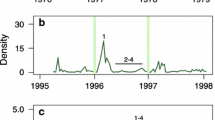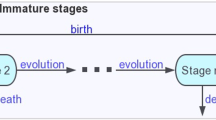Abstract
Some insect populations exhibit cycles in which successive population peaks may correspond to effectively discrete generations. Motivated by this observation, we investigate the structure of matriarchal generations in five simple, continuous-time, stage structure models in order to determine the proportion of individuals in one population peak who are the offspring of individuals in the pervious peak. We conclude that in certain models (including a model of Nicholson's blowflies) successive population peaks do not correspond to discrete generations, whereas in others (including some models of uniform larval competition) successive peaks may well approximate discrete generations. In all models, however, there is eventually significant overlap of generations.
Similar content being viewed by others
Literature
Bellows, Jr., T. S. 1981. The descriptive properties of some models for density dependence.J. Anim. Ecol. 50, 139–156.
Bellows, Jr., T. S. 1982. Simulation models for laboratory populations ofCallosobruchus chinensis andC. maculatus.J. Anim. Ecol. 51, 597–623.
Bellows, Jr., T. S. and M. P. Hassell 1988. The dynamics of age structured host parasitoid interactions.J. Anim. Ecol. 57, 259–268.
Crowley, P. H., R. M. Nisbet, W. S. C. Gurney and J. H. Lawton 1987. Population regulation in animals with complex life histories: formulation and analysis of a damselfly model.Adv. Ecol. Res. 17, 1–59.
Diekmann, O., R. M. Nisbet, W. S. C. Gurney and F. van den Bosch. 1986. Simple mathematical models for cannibalism: a critique and a new approach.Math. Biosci. 78, 21–46.
Ebenman, B. 1988. Competition between age classes and population dynamics.J. theor. Biol. 131, 389–400.
Godfray, H. C. J. and M. P. Hassell 1989. Discrete and continuous insect populations in tropical environments.J. Anim. Ecol. 58, 153–174.
Gurney, W. S. C., S. P. Blythe and R. M. Nisbet 1980. Nicholson's blowflies revisited.Nature 187, 17–21.
Gurney, W. S. C., R. M. Nisbet and J. H. Lawton 1983. The systematic formulation of tractable single species population models including age-structure.J. Anim. Ecol. 52, 479–495.
Gurney, W. S. C. and R. M. Nisbet 1985. Generation separation, fluctuation periodicity, and the expression of larval competition.Theor. Pop. Biol. 28, 150–180.
Hastings A. 1987. Cycles in cannibalistic egg larval interactions.J. math. Biol. 24, 651–666.
Hastings, A. and R. F. Constantino 1987. Cannibalistic egg-larval interactions inTribolium: an explanation for the oscillations in larval numbers.Am. Nat. 130, 36–52.
Jones, A. E., R. M. Nisbet, W. S. C. Gurney and S. P. Blythe 1988. Period to delay ratio near stability boundaries for systems with delayed feedback.J. math. Anal. Appl. 135, 354–368.
Lawton, J. H. and M. P. Hassell 1981. Asymmetric competition in insects.Nature (Lond.) 289, 793–796.
MacDonald, N. 1976. Avoiding chaos in population models.Math. Biosci. 31, 255–257.
May, R. M. 1974.Stability and Complexity in Model Ecosystems. Princeton University Press.
Maynard Smith, J. 1974.Models in Ecology. Cambridge University Press.
Nicholson, A. J. 1954. An outline of the dynamics of animal populations.Aust. J. Zool. 2, 9–65.
Nicholson, A. J. 1957. The self adjustment of populations to change.Cold Spring Harb. Symp. quant. Biol. 22, 153–173.
Nisbet, R. M. and J. R. Bence 1989. Alternative dynamic regimes for canopy forming kelp: A variant on density vague population regulation.Am. Nat., in press.
Nisbet, R. M. and W. S. C. Gurney 1982.Modelling Fluctuating Populations. New York: Wiley.
Nisbet, R. M., W. S. C. Gurney and J. A. J. Metz 1989. Stage structure models applied in evolutionary ecology. InMathematical Ecology II, L. A. Gross, T. Hallam and S. A. Levin (eds). Heidelberg: Springer Verlag.
Oster, G. 1976. Internal variables in population dynamics. InLect. Math. Life Sci. 8, 37–68.
Prout, T. and F. McChesney 1985. Competition among immatures affects their adult fertility: population dynamics.Am. Nat. 126, 521–558.
Readshaw, J. L. and W. R. Cuff 1980. A model of Nicholson's blowfly cycles and its relevance to predation theory.J. Anim. Ecol. 49, 1005–1010.
Rubinow, S. I. and R. Oppenheim Berger 1979. Time-dependent solution to age-structured equations for sexual populations.Theor. Pop. Biol. 16, 35–47.
Stokes, T. G., W. S. C. Gurney, R. M. Nisbet and S. P. Blythe 1988. Parameter evolution in a laboratory insect population.Theor. Pop. Biol. 34, 248–265.
Takahashi, F. 1973. An exponential study on the suppression and regulation of the population ofCadia cantella (Walker) (Lepidoptera: Pyralidae) by the action of a parasitic wasp,Nemeritis canescens Gravenhorst (Hymenoptera: Ichneumonidae). Mem. Col. Agric. Kyoto Univ.104, 1–12.
Varley, G. C., G. R. Gradwell and M. P. Hassell 1973.Insect Population Ecology. London: Blackwell Scientific.
White, E. E. and C. B. Huffaker 1969. Regulatory processes and population cyclicity in laboratory populations ofAnagasta kueniella (Zeller) (Lepidoptera: Phycitidae). I: Competition for food and predation.Res. Pop. Ecol. 11, 57–83.
Author information
Authors and Affiliations
Rights and permissions
About this article
Cite this article
Jansen, V.A.A., Nisbet, R.M. & Gurney, W.S.C. Generation cycles in stage structured populations. Bltn Mathcal Biology 52, 375–396 (1990). https://doi.org/10.1007/BF02458578
Received:
Accepted:
Issue Date:
DOI: https://doi.org/10.1007/BF02458578




